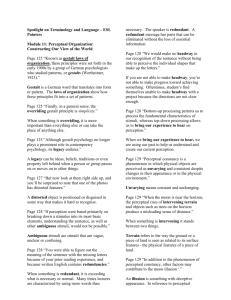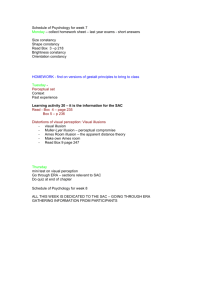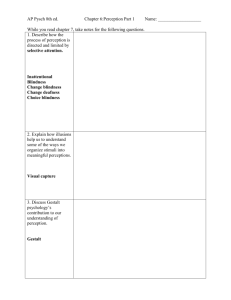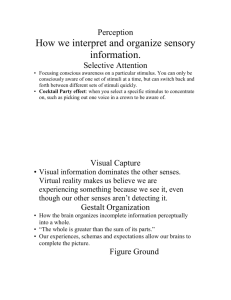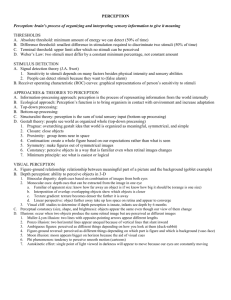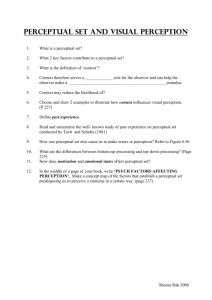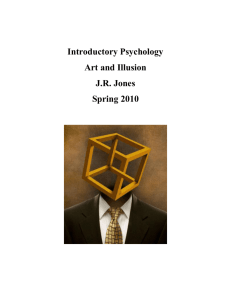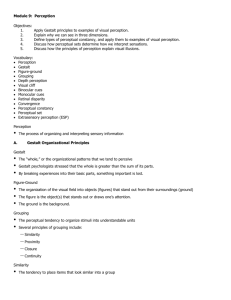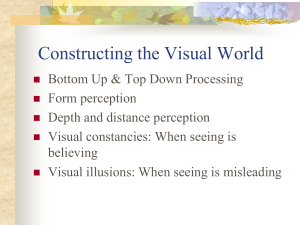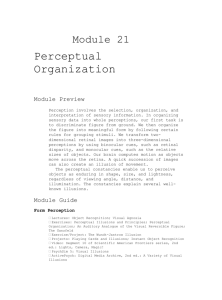File
advertisement
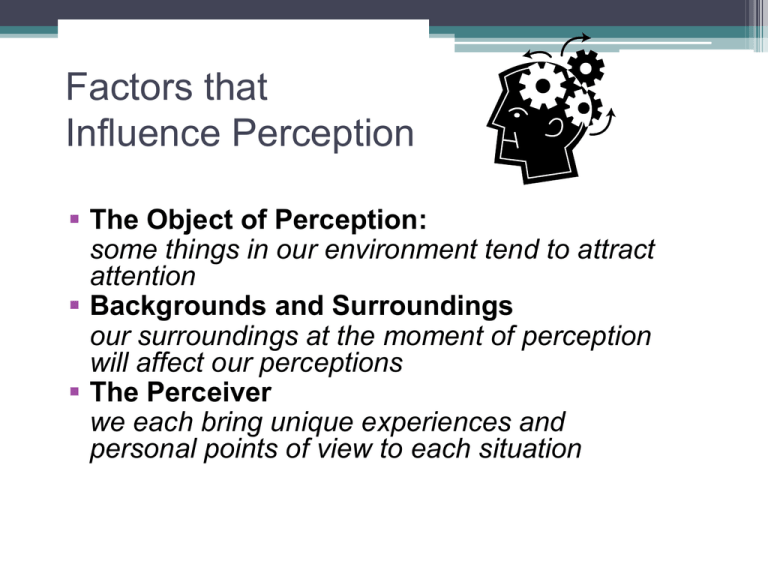
Factors that Influence Perception The Object of Perception: some things in our environment tend to attract attention Backgrounds and Surroundings our surroundings at the moment of perception will affect our perceptions The Perceiver we each bring unique experiences and personal points of view to each situation Form Perception • Gestalt principles describe the brain’s organization of sensory building blocks into meaningful units and patterns. Figure and Ground • Proximity ▫ Seeing 3 pair of lines in A. • Similarity ▫ Seeing columns of orange and red dots in B. • Continuity ▫ Seeing lines that connect 1 to 2 and 3 to 4 in C. • Closure ▫ Seeing a horse in D. Gestalt and the Urge to Organize Other gestalt principles Simplicity Gestalt Principles: Closure Gestalt Principles: Continuity Gestalt Principles: Proximity Gestalt Principles: Similarity Depth and Distance Perception • Binocular Cues: ▫ Visual cues to depth or distance that require the use of both eyes. ▫ Convergence: Turning inward of the eyes, which occurs when they focus on a nearby object ▫ Retinal Disparity: The slight difference in lateral separation between two objects as seen by the left eye and the right eye. Depth and Distance Perception • Monocular Cues: ▫ Visual cues to depth or distance that can be used by one eye alone. The Ames Room • A specially-built room that makes people seem to change size as they move around in it • The room is not a rectangle, as viewers assume it is • A single peephole prevents using binocular depth cues Visual Constancies • The accurate perception of objects as stable or unchanged despite changes in the sensory patterns they produce. ▫ ▫ ▫ ▫ ▫ Shape constancy Location constancy Size constancy Brightness constancy Color constancy Shape Constancy • Even though these images cast shadows of different shapes, we still see the quarter as round Muller-Lyon Illusion Which is longer? Muller-Lyon Illusion Visual Illusions • Illusions are valuable in understanding perception because they are systematic errors. ▫ Illusions provide hints about perceptual strategies • In the Muller-Lyer illusion (above) we tend to perceive the line on the right as slightly longer than the one on the left. The Ponzo Illusion • Linear perspective provides context • Side lines seem to converge • Top line seems farther away ▫ But the retinal images of the red lines are equal! Fooling the Eye • The cats in (a) are the same size • The diagonal lines in (b) are parallel • You can create a “floating fingertip frankfurter” by holding hands as shown, 5-10” in front of face. ©1999 Prentice Hall Perceptual Powers: Origins and Influences • Inborn abilities and perceptual lessons • Psychological and cultural Influences on perception • Glass surface, with checkerboard underneath at different heights ▫ Visual illusion of a cliff ▫ Baby can’t fall • Mom stands across the gap • Babies show increased attention over deep side at age 2 months, but aren’t afraid until about the age they can crawl (Gibson & Walk, 1960) The Visual Cliff The Visual Cliff ©1999 Prentice Hall Critical Period • If infants miss out on experiences during a crucial period of time, perception will be impaired. • When adults who have been blind since birth have vision restored, they may not see well • Other senses such has hearing may be influenced similarly. ©1999 Prentice Hall Psychological and Cultural Influences on Perception • We are more likely to perceive something when we need it. • What we believe can affect what we perceive. • Emotions, such as fear, can influence perceptions of sensory information. • Expectations based on our previous experiences influence how we perceive the world. ▫ Perceptual Set A habitual way of perceiving, based on expectations. • All are influenced by our culture. Perceptual Set Perceptual Set Perceptual Set Perceptual Set ©1999 Prentice Hall • What you see in the center figures depends on the order in which you look at the figures: ▫ If you scan from the left, see an old man ▫ If you scan from the right, see a woman’s figure Extrasensory Perception • Extrasensory Perception (ESP): ▫ The ability to perceive something without ordinary sensory information ▫ This has not been scientifically demonstrated • Three types of ESP: ▫ Telepathy – Mind-to-mind communication ▫ Clairvoyance – Perception of remote events ▫ Precognition – Ability to see future events Context Effects • The same physical stimulus can be interpreted differently • We use other cues in the situation to resolve ambiguities • Is this the letter B or the number 13? Parapsychology • J. B. Rhine conducted many experiments on ESP using stimuli such as these. • Rhine believed that his evidence supported the existence of ESP, but his findings were flawed. In order to make sense of our world our brains try to see patterns or shapes that are recognizable. This principle is called “grouping”. The mind forms shapes that don't exist. Parallel Lines? Embedded Images http://psycharts.com/opt_illus.html 2 dimensional chalk drawing After a Necker cube is perceived from one perspective, it naturally tends to change to the other in about 3 seconds. • When you look at the top figure, your visual system will organize the elements into a box. The box will reverse, as in the Necker Cube illusion. The elements in the bottom figure have terminations and do not readily group into a box figure that shows reversals How fast do you switch? You will see it flip into a second staircase • M.C. Escher used complex variations on this illusion to achieve some wonderful effects like showing representations of people walking in opposite directions, both descending. He also joined staircases into an appearance of infinite ascent/descent. M.C. Escher Compare the shades of red… The shades of red are identical The difference in the appearance is related to the influence of the backgrounds . When you look at the figure you will see either a vase or two faces. If you continue to look, the figure will appear to shift to the alternative organization Old Woman or Young Girl? Man/Woman Shimmer Any movement you see is an illusion! Straight Lines? Hermann Grid Impossible Triangle and Trident http://psycharts.com/opt_illus.html What is wrong with this sign? http://www.keele.ac.uk/depts/aa/widening/uniworld/webclub/rs/optical.htm One more… Perspective is evoked in this image by the pattern, and the lines on the wall which converge on to a common point in the distance. http://www.sapdesignguild.org/resources/optical_illusions/perspective.html & http://www.killsometime.com/illusions/Optical-Illusion.asp?Illusion-ID=36
